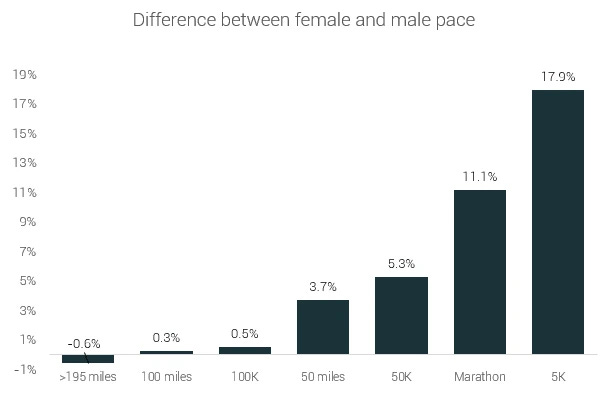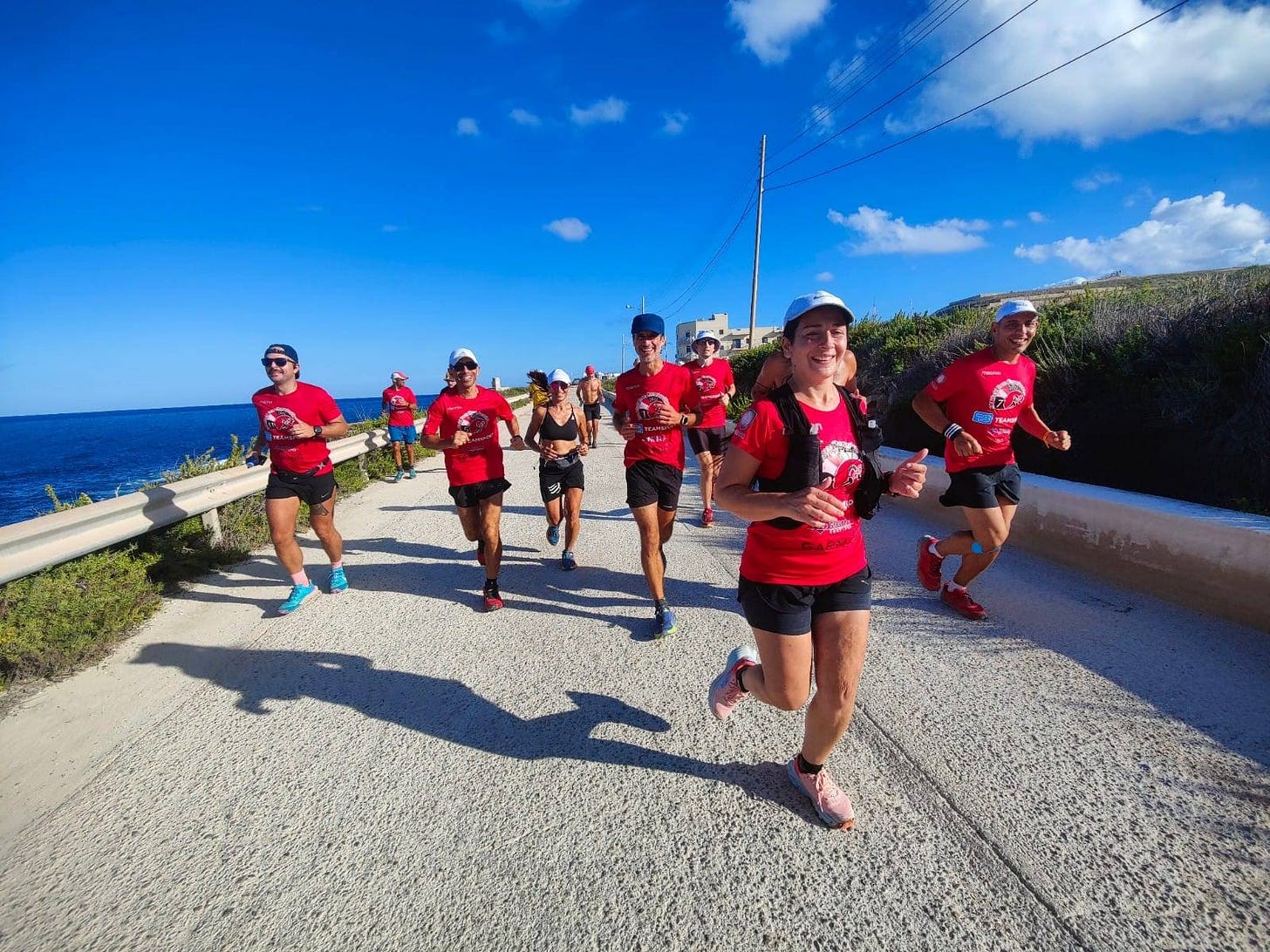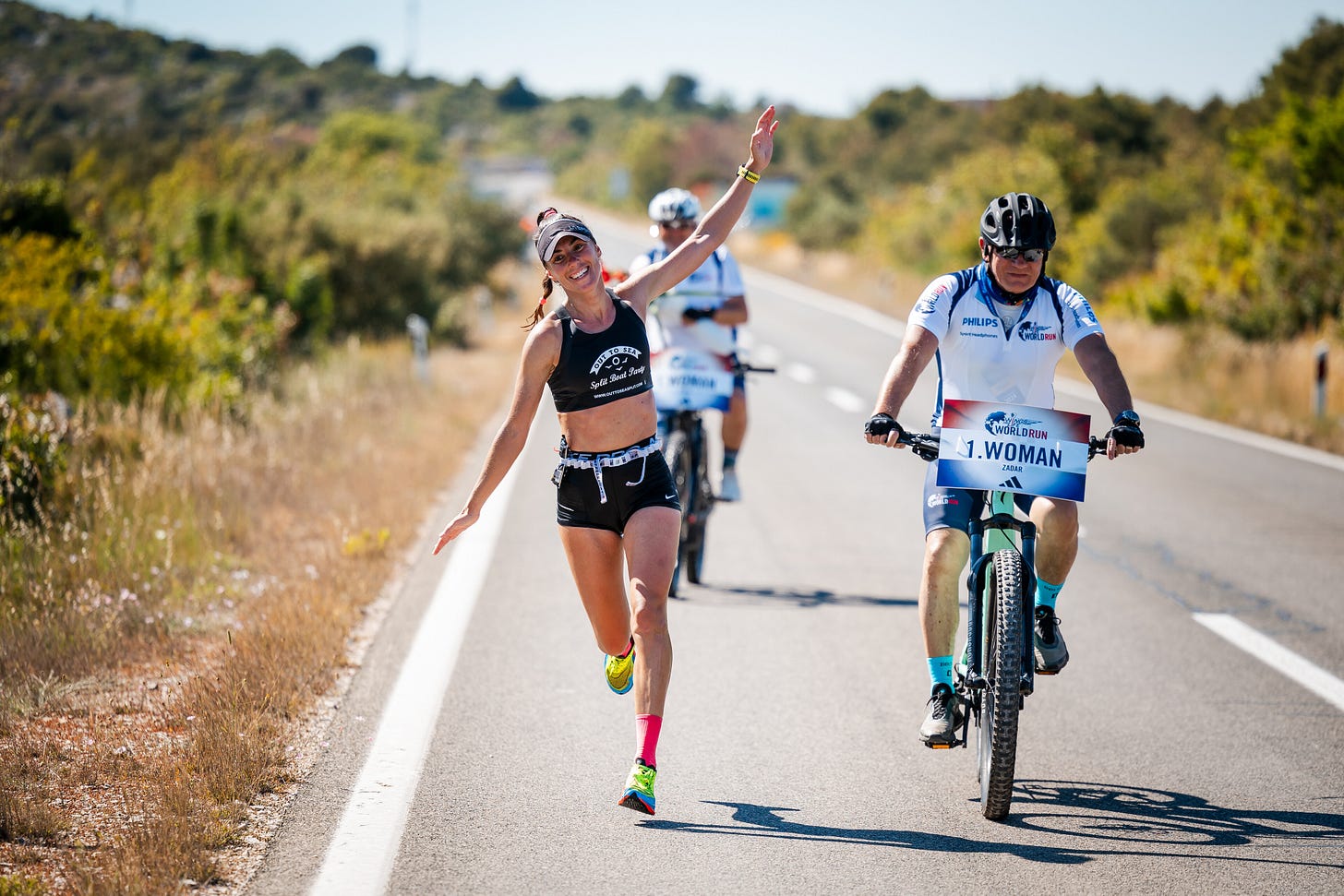Are Women Better Ultra Runners Than Men?
Mainstream media claims that women are superior ultra runners to men, but does the data hold up? What does the science reveal about sex differences in extreme endurance?
In 2017, Courtney Dauwalter outright won the inaugural Moab 240 race, finishing approximately 10 hours ahead of the second-place competitor, who was a man. This result drew significant media attention, with many using it as an example to show that women are better ultra runners than men [1, 2, 3].
However, this wasn’t the only time a woman won an ultra running race. In January 2018, Jasmin Paris outright won the Spine Race, finishing 15 hours ahead of the next participant. Later that year, Maggie Guterl was the last athlete standing at Big's Backyard Ultra, having covered the greatest distance in the field.
These instances are particularly noteworthy because they represent outright victories by women in highly competitive events that included top male athletes who are seasoned veterans with extensive backgrounds in endurance sports, not casual competitors.
However, this pattern contrasts performance trends observed in sub-ultra running races, where outright wins by women at the elite level are unheard of. This difference in performance between ultra-endurance and shorter distances naturally leads to a compelling question: why might women be achieving these results in extreme endurance challenges, and what does the existing research tell us about potential sex differences in ultra-endurance performance?

Theories on Female Advantage
Following the media attention sparked by those ultra-endurance performances, various outlets began proposing reasons why females are outperforming males at ultra events.
One prominent theory centered on the difference in hormonal profiles between the two sexes, suggesting that the higher estrogen levels in females makes them better adapted at burning fat. Given that ultra-endurance efforts often involve prolonged periods at lower intensities where the body relies more heavily on fat as a primary fuel source, this proposed difference offers females an advantage by allowing them to conserve their limited carbohydrate stores and expend less energy over long distances.
Beyond physiological explanations, another idea frequently discussed was that females possess greater mental toughness and resilience compared to males, a trait crucial for pushing through the physical and psychological barriers of ultra-distance events. It's worth noting that while some studies confirm this, the scientific literature on sex differences in mental endurance, whether in sports performance or dealing with challenges like injury, presents a conflicting picture.
However, before we delve deeper into the scientific understanding of sex differences in ultras, it's important to trace back to the specific piece of analysis that fueled the widely reported claim that females are better ultra-endurance runners than males.
The Report That Sparked the Debate
In 2020, a report titled 'The State of Ultra Running' was released by the shoe review website RunRepeat. Among its key results was the following statement:
Female ultra runners are faster than male ultra runners at distances over 195 miles. The longer the distance the shorter the gender pace gap.
This result was accompanied with the following visual.

However, a closer examination of the methodology behind this particular finding reveals a crucial detail. RunRepeat's analysis involved calculating the average finishing pace for all participants in various distance categories, separated by sex, and then comparing these average figures. The result indicating female runners were faster over 195 miles meant that, on average, the collective group of female finishers in races of roughly that distance completed the course at a faster average pace than the collective group of male finishers.
The critical point here lies in the distinction between an average pace calculated across a broad group of participants and the peak performance. Comparing the average pace of finishers in a race category does not tell us whether the fastest female runner is faster than the fastest male runner, or reflect the relative finishing positions of male and female athletes within the field. The data, as presented in this specific finding, indicated a difference in a statistical average between two pools of participants, not a direct comparison of peak performance.
Regrettably, the nuance of this 'average pace' analysis appears to have been overlooked in many of the media reports that cited the RunRepeat finding. Interpreting this specific result as proof that females are 'better' or 'faster' ultra-endurance runners than males misrepresents what the data actually showed.
Understanding the limitations of this foundational claim is important before we turn our attention to peer-reviewed scientific literature, which offers a more comprehensive perspective on potential biological and physiological differences between male and female athletes in ultra-endurance events.
Beyond the Headlines: Scientific Perspectives on Ultra-Endurance
Having examined the specific analysis that initiated the media claim about female superiority in ultra-endurance, it's clear that a scientific perspective is needed. To move beyond headlines, I explored the existing peer-reviewed research. This section will delve into three key areas to provide a clearer picture of potential sex differences in ultra-endurance performance: elite performance results along with underlying physiological capabilities and psychological factors.
Elite Performance Analysis
One direct way to investigate performance differences between the sexes is by analyzing the results of top finishers in competitive races.
Tiller and Illidi conducted an analysis of ultra-distance running races where the number of participating males and females was relatively balanced. They observed that while the median finishing time for all participants was roughly similar between sexes, the fastest ten male finishers were quicker than the fastest ten female finishers. A limitation of this particular review is that, due to the criteria of balanced sex participation, only two races met the criteria for inclusion in their analysis.
However, a similar study by Millet and Malatesta, who analyzed winning times for both sexes across three major European ultra-marathons (UTMB, CCC, and OCC) between 2011 and 2022, found the performance discrepancy between the winning male and female times to be approximately 16.5%.
Looking at slightly older data, Coast et al. examined top finisher results from races ranging from 100 meters up to 200 kilometers prior to 2003. Their findings indicated that the difference in finish times between the sexes appeared to increase with distance, particularly in the ultra-distance events they reviewed. While this research provides an interesting historical perspective, the fact that it was conducted over two decades ago suggests the results may not fully reflect current performance trends.
These findings from elite race results present a complex picture. The consistent observation across different analyses is that among the very fastest competitors, a performance gap exists between male and female ultra runners, which in some studies appears to be larger than the typical percentage difference observed in sub-ultra events.
Understanding the potential reasons behind this observed difference requires looking deeper into the athlete's physiology.

Sex-Specific Physiology Within Ultra-Running
To understand whether biological factors might contribute to performance variations, researchers have investigated physiological differences between male and female athletes relevant to ultra-endurance.
Studies have consistently pointed to several potential physiological distinctions. Arnesen and Norder, for instance, found that females tend to have a higher proportion of Type I muscle fibers. These fibers are more geared towards aerobic activity and are known for their increased resistance to fatigue, potentially contributing to better preservation of strength and neuromuscular function during prolonged efforts. They also noted that females demonstrate a greater capacity to oxidize fat for fuel, which is advantageous during ultra-endurance events where fat becomes a primary energy source.
Similar findings regarding muscle composition, fat oxidation and fatigue resistance were reported by Besson et al. Their work also highlighted that female runners often exhibit a more consistent pacing strategy and noted subtle differences in running biomechanics linked to anatomical variations. However, their analysis also included factors that could counterbalance these potential advantages, such as a lower oxygen-carrying capacity and higher average body fat percentages in females compared to males.
Adding further nuance, Tiller et al. conducted a comprehensive review that reinforced many of the points regarding muscle fibers, fat oxidation, and pacing. They also introduced additional considerations, suggesting that increased fatigue resistance in females might not solely be due to a higher proportion of Type I fibers, but potentially also linked to smaller muscle fiber diameters allowing for improved blood flow. Their review also discussed how higher estrogen levels in females might influence tendon stiffness, potentially affecting running economy and injury risk. Furthermore, they noted that females tend to have smaller stomach volumes and slower digestive emptying times, which could impact fueling strategies during extremely long events.
Collectively, these physiological studies indicate that while females may possess certain potentially beneficial characteristics for ultra-endurance, these exist alongside other physiological differences that could negatively influence overall performance, presenting a complex interplay of factors rather than a simple set of clear-cut advantages.
Motivation and the Ultra Mindset
Beyond the physical differences, psychological attributes like motivation, decision-making and mental resilience are undoubtedly critical in ultra-endurance sports. However, objectively measuring and comparing these "mental differences" between the sexes is often more challenging than assessing physiological traits.
Research exploring psychological aspects in runners has yielded interesting, though inconclusive, findings. A study by Mogas Amoros involving Spanish marathon runners observed that participants frequently made optimistic predictions about their race times, and this tendency towards overconfidence was more pronounced in males than in females. Interestingly, the study also noted a non-significant trend where, in groups with a higher percentage of female participants, the level of overconfidence between males and females seemed to converge.
Another study examining differences in overconfidence, this time within a cliff diving context, found a greater likelihood for male divers to exhibit overconfidence compared to female divers, although the actual amount of overestimation was considered similar between the sexes.
When looking specifically at motivation within an ultra-marathon population, studies suggest differences in the primary drivers for participation. Male runners have been shown to exhibit higher motivation levels towards achieving personal goals and self-esteem benefits while female runners prioritise personal success. This leads me to believe that female ultra-runners place a higher value on the successful completion or achievement of a goal itself, whereas male runners might place greater emphasis on the pursuit of ambitious personal goals, even if they carry a higher risk of not being fully achieved.
However, interpreting these motivational differences in terms of who is inherently "mentally tougher" for ultra-endurance remains complex and subject to ongoing research.

Beyond Science
Based on the available scientific literature on elite performance times, physiological traits, and psychological factors, the picture regarding sex differences in ultra-endurance is considerably more nuanced than suggested by simplified media headlines. While certain physiological and psychological tendencies are observed, it's challenging to definitively conclude that one sex is inherently 'better' suited overall. Furthermore, focusing purely on biological or psychological differences overlooks other significant factors that can influence participation and performance at the highest levels of sport – namely, the societal and systemic barriers that athletes, particularly women, may face.
The Impact of Culture and Societal Factors
Moving beyond the physiological and psychological differences explored in the scientific literature, any comprehensive understanding of sex differences in ultra-endurance must also account for disparities in participation. A consistent observation across many studies is the significantly lower number of female athletes training for and competing in ultra-endurance running events compared to male athletes. This fundamental difference in participation rates inherently impacts data availability and complicates analyses aimed at comparing performance across the sexes.
Research has begun to explore the reasons behind this participation gap, identifying several potential barriers specifically impacting women. A North American study investigated factors cited by women as reasons for their resistance or hesitation towards ultra-marathon participation. The most frequently mentioned challenges included time conflicts arising from responsibilities such as raising children and managing household duties which interfere with the significant time commitment required for training. Fear and intimidation related to the extreme distance and the often solitary nature of ultra-marathons were also cited as significant concerns.
Further insights come from a 2021 study focused on participation in two specific Scottish ultra-races. Interestingly, their data indicated that a higher proportion of male participants reported having dependents compared to female participants yet, overall female participation in the races remained lower than that of males. This finding suggests that while time constraints related to family responsibilities are certainly a factor, understanding gender-specific barriers may involve more complex dynamics. The study did note a positive trend: female participation has been steadily rising over time, though the participation gap persists, being more pronounced in longer ultra-distance events. Additionally, female participants found the ultra-running community to be inclusive, identifying no overt male bias within the community culture itself.
An in-depth literature review by Bernd Frick offers a broader perspective, suggesting that while the level of competitiveness between the sexes in endurance sports has shown a trend towards narrowing over time, the primary factors currently limiting female participation and performance at the highest levels are cultural and incentive-based elements. As supporting evidence, Frick notes that the competitive performance gap has decreased more rapidly in sports or events where financial rewards or other incentives for female athletes are higher. Furthermore, cultural aspects play a significant role, as athletes are often influenced to participate in sports or events where they see people with similar cultural backgrounds and societal roles. This perspective highlights the potential for reducing the participation gap through targeted incentives (an area where organizations like SheRACES are already making strides) and by increasing the visibility and elevation of athletes from underrepresented groups within the community.
Considering these societal factors – the challenges of balancing training with traditional roles, the influence of cultural representation, and the impact of incentives – adds crucial context to the scientific findings on performance and physiology. They underscore that the observed differences in ultra-endurance between the sexes are not solely a matter of biology or psychology, but are also shaped by the environment in which athletes train and compete, influencing who participates and who reaches their full potential.
The Complex Reality
Having journeyed through the initial headlines, the specific data analysis that fueled the claim, and a range of scientific perspectives, I've spent considerable time exploring the question of whether female ultra-endurance runners hold an advantage over their male counterparts. Based on this exploration, my feeling is that we are not yet equipped to provide a definitive answer.
While the initial analysis widely cited in the media appears to have been based on a misinterpretation, the broader scientific literature reveals a complex picture. Looking at the fastest finishing times in competitive races suggests that top male runners maintain a performance advantage over top female runners. However, whether the magnitude of this performance gap at ultra-distances is truly larger or smaller than that observed in shorter endurance events remains challenging to conclusively determine.
Unfortunately, the reality of significant disparities in participation cannot be overlooked. Societal and cultural factors often present greater barriers for women seeking to enter and commit to the demanding training required for ultra-running. These external influences, combined with potential biological considerations like childbirth during key athletic development years, may impact the pool of female athletes reaching their full potential.
Ultimately, ultra running remains a young and developing sport. The depth and breadth of consistently collected data across equally competitive male and female fields is still growing. The professional infrastructure and scientific understanding, while advancing rapidly, are not yet as established as in more mature sports.
I hope that as ultra running continues to grow, it inspires further research that provides a more complete understanding of human capabilities and potential in these incredible tests of endurance, benefiting athletes of all sexes.






Tarahumara Woman Won Ultramarathon Running in Sandals in Mexico